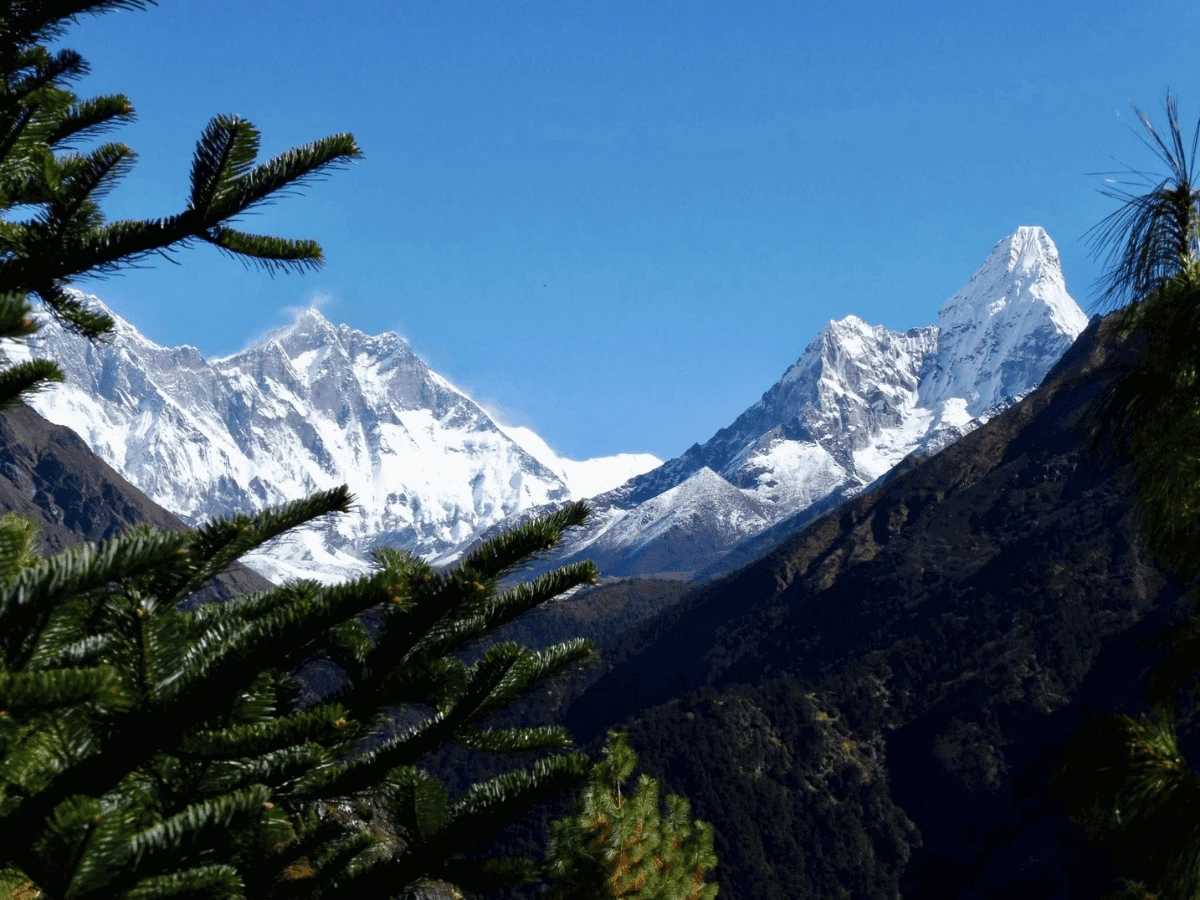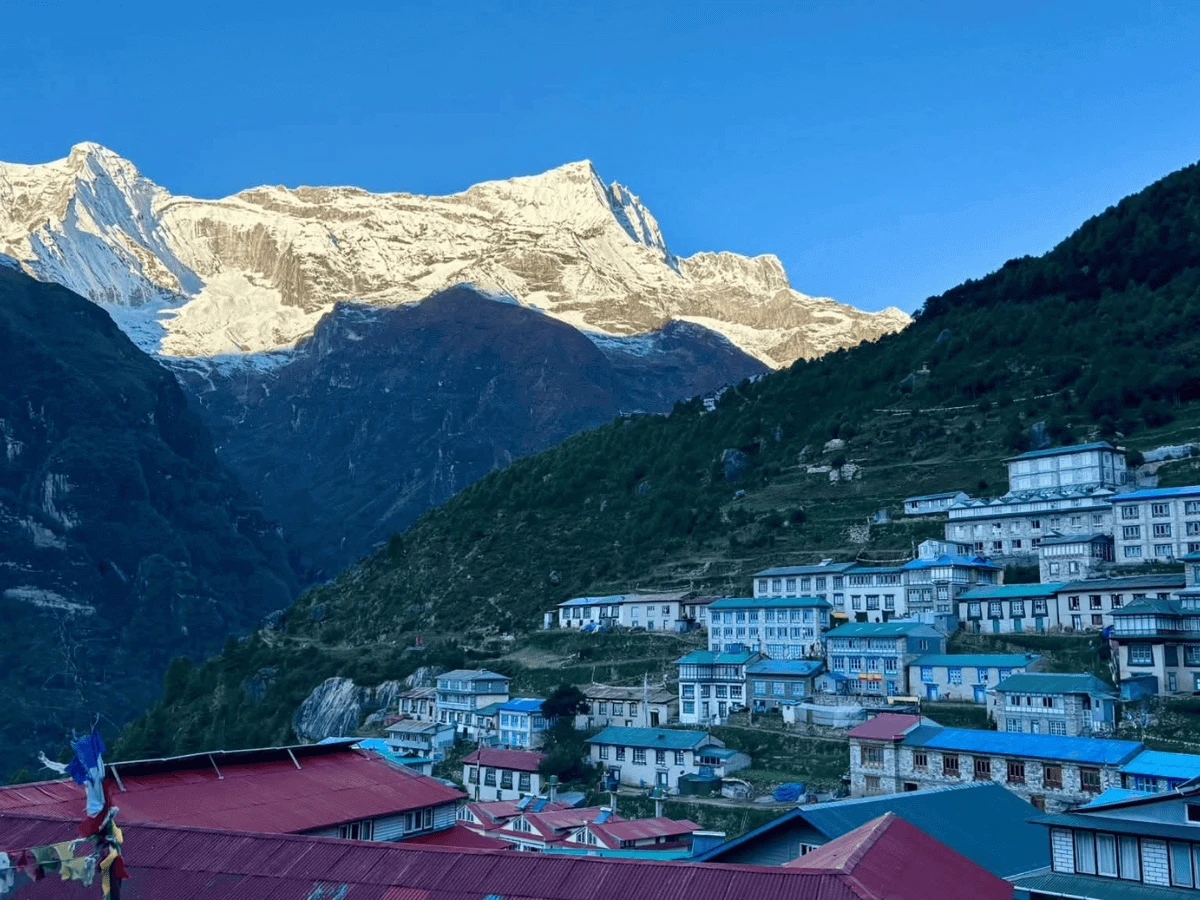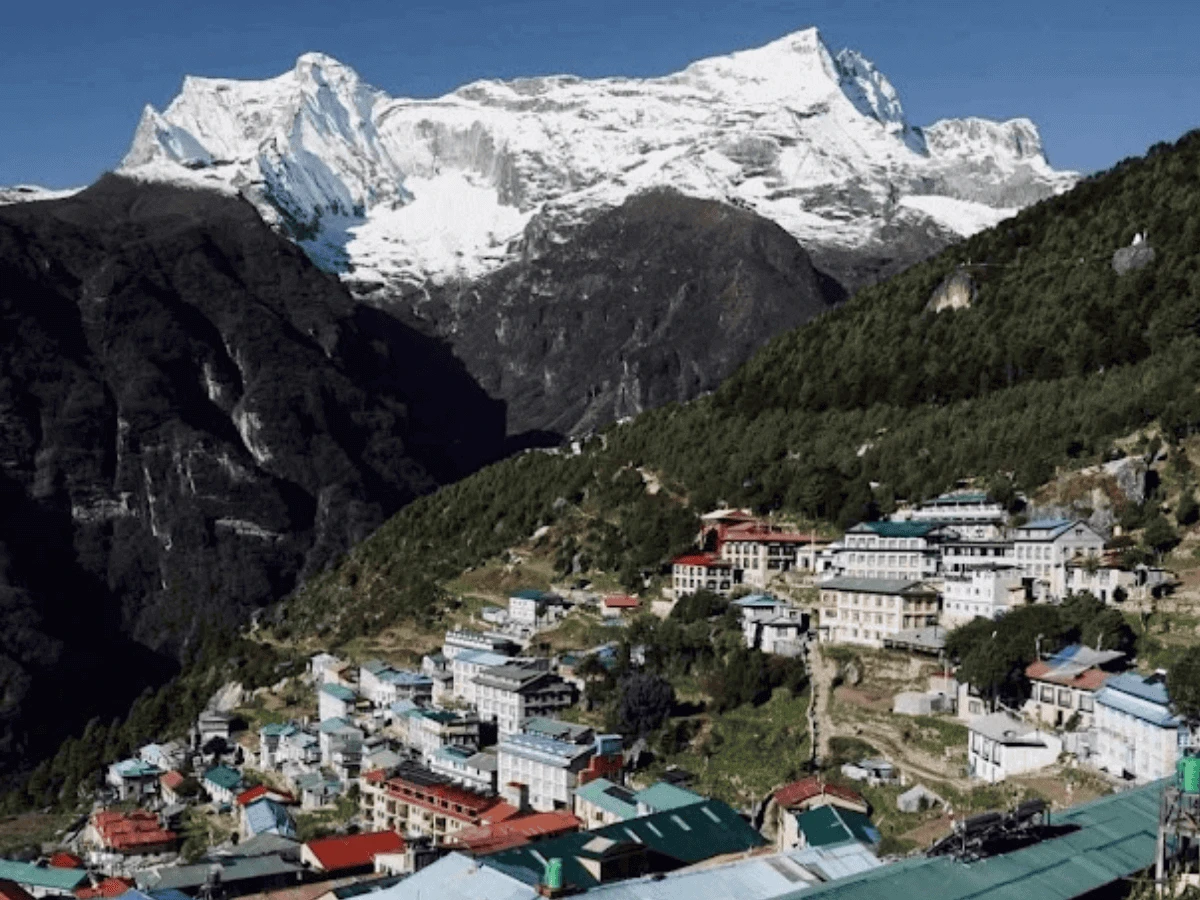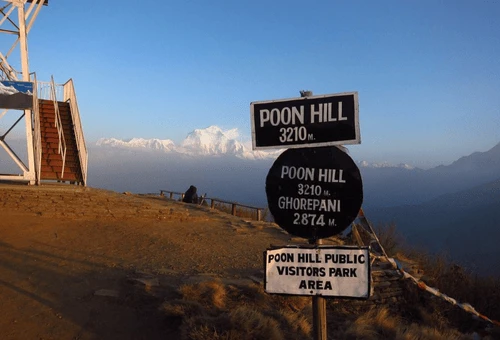The Everest View Trek, also known as the Everest Panorama Trek, is widely regarded as the best short trek to witness Mount Everest without doing a classic Everest Base Camp Trek 14 Days. This 5-day trek offers a stunning panorama of Himalayan peaks, including Everest, Lhotse, Nuptse, Ama Dablam, Thamserku, and more. Trekkers walk through the heart of the Khumbu Region, lush forests of rhododendron and pine, prayer flag–draped bridges, and picturesque villages, immersing themselves in the rich culture and warm hospitality of the local people.
The Everest View Trek, a 5-day adventure, begins with a thrilling flight to Lukla, the gateway to the Everest region. From Lukla, it follows the popular mountain trail of Everest along the Dudh Koshi River to the bustling Sherpa town of Namche Bazaar (3,440 m). Namche is located within Sagarmatha National Park, a UNESCO World Heritage Site recognised in 1979 for its outstanding natural beauty and unique cultural significance.
One of the best aspects of the Everest View Trek is that it is a short and suitable option for all age groups. In just five days on the trail, you get a genuine taste of trekking in the Himalayas, complete with steep climbs, suspension bridges, and crisp mountain air, without any difficulties.
You will reach the highest point is Namche Bazaar, at 3,440 meters (11,286 feet). From here, there are a few options for the hike. Everest View Hotel Hike or Hike to Khumjung Village could be the best option. If you are planning the Mount Everest View Trek, let us organise this memorable trip for you. Feel Free to contact us via email or WhatsApp us at +9779849790153 for more information regarding the trek.
Why Choose the Mount Everest View Trek 5 Days?
Why choose this 5-day Everest View Trek over other treks? Simply put, it’s the ultimate short-trek experience in Nepal for seeing Mt. Everest up close. Here are a few compelling reasons to opt for this adventure:
- Spectacular view of Everest in a quick time: If your dream is trekking to see Mount Everest without spending two weeks on the trail, this trek is perfect.
- Moderate & Beginner-Friendly: The Everest View Trek is considered one of the best easy treks in Nepal, delivering significant rewards. The highest altitude reached (around 3,880 m during a day hike) is moderate, meaning the risk of altitude sickness is lower than on longer, higher treks.
- Family-Friendly Adventure: Mount Everest View Trek is a family-friendly venture that is suitable for kids and elderly citizens.
- Cultural Immersion: Beyond mountains, the trek offers a deep dive into Sherpa culture without straying too far from comfort. You’ll stay in teahouses run by local families, visit monasteries, and wander the markets of Namche Bazaar, where traders from nearby villages converge. At Namche, don’t miss the Sherpa Museum or the Saturday market if your schedule aligns.
- Quick Return to Comfort: Since the journey is short, you can be back in Kathmandu in no time. Not everyone can afford a long holiday; with this trek, you get a world-class adventure and still have days to spare for other activities in Nepal or simply flying home to resume work. In five days, you’ll have memories to last a lifetime – without using up all your vacation days!
Trek to Mount Everest View in 5 Days with your Family
Is the Everest View Trek suitable for families? Absolutely yes! This route is often recommended as an Everest Family Trek, one of the rare adventures that both parents and children can enjoy together in the Nepal Himalayas. Here’s why it works so well for families:
- Short and Easy Trek with no difficulties for the children and the elderly.
- Manageable Daily Hikes with fewer walking hours. On average, you will walk around 5-6 hours without any hassle.
- Comfortable Accommodation along the Everesy View Trek Route makes this trip more family-friendly.
- Flexible Itinerary makes this trip smoother. If you want to add more days to the Everest View Trek Itinerary, then we are flexible to modify the itinerary for you.
Overall, the Everest View Trek allows families to bond through adventure. Sharing the moment of watching the first rays of sunrise on Everest together, or cheering as you cross a swaying bridge above a river, brings a family closer in a way few other experiences can. It’s an inspiring journey that will give your family stories to tell for years – the kind of experience that might even spark a lifelong love of the outdoors in your children!
Best Easy Trek in Nepal for Beginners to See Mount Everest
The Everest View Trek is one of the best short treks in Nepal for beginners to see Mount Everest. The trek to Namche Bazaar and Everest View Hotel delivers breathtaking views of Mount Everest, Ama Dablam, Lhotse, and several peaks. It’s often considered the easiest trek to see Everest because it efficiently balances effort and reward.
The Everest View Trek remains the top pick for an easy Everest viewing trek because it is short and the nearest trekking destination from Kathmandu. It delivers on its promise – you get to see Mount Everest – while keeping things manageable and enjoyable. And if you fall in love with the Everest views, you’ll have plenty of inspiration to do the Everest Base Camp Trek or even Gokyo Valley Trek.
The Everest View Trek is perfect for those who want to start their trekking journey. It is rated as the best short trek in Nepal to view Mount Everest. The Everest View Trek itinerary smartly includes an acclimatisation day at Namche Bazaar, where you don’t push to a higher camp but instead take a light hike to a higher altitude (3,880 m) and return to Namche to sleep.
5-Day Everest View Trekking Package Cost for 2026,2027
The Everest View Trek costs start from USD 999 per person, which covers the flight fare from Kathmandu-lukla-Kathandu, meals, accommodation, guide, and so on. The price per person can vary depending on group size, season, and specific requirements. We often have a discounted rate for larger groups, and prices can be slightly higher if it’s a solo trek or a custom private departure with additional services.
Note: Sometimes on our website or promotional materials, you might see seasonal offers. For early bookers or off-peak season (winter/monsoon), we occasionally run special promotions. Always inquire if any discount or offer applies – we strive to be fair and transparent in pricing.
Why Choose Mountain Eco Trails for the Everest View Trek?
Choosing the right trekking company can make a huge difference in your experience. Mountain Eco Trails specialises in Everest and other Nepal treks, providing a balance of safety, professionalism, and local expertise. Here are a few reasons to trek with Mountain Eco Trails:
- Experienced crew members and official team.
- Flexible and customised Langtang Trek Itinerary with personalised service.
- Complimentary Services like Duffel Bag, Trekking Poles, SIM Card, and an hour trekker's massage
- First Aid Kit with basic medication.
- Hassle-free last-minute booking and trip arrangements.
- Competitive and Fair price that matches the services and has no hidden costs.
- Special Discount for a group of trekkers of more than 5 Pax.
With Mountain Eco Trails, you trek with a trusted local company that prioritises your experience, safety, and the environment. We strive to turn your Langtang journey into an incredible memory you’ll cherish for life. Want to know more details about the trip? Feel free to reach out to us via email or contact us directly via WhatsApp at +9779849790153






